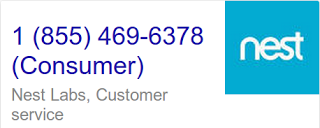Webmaster level: All
Every day, searchers use Google to find information about businesses. Common queries include finding the phone number for customer service, the location of a business, and opening hours.
This information is typically found in a business's location page or a "contact us" section of a company's website. When Google correctly identifies these pages and is able to extract the relevant information from them, it is more likely to surface that information to searchers looking for the business.
Today we would like to share our recommendations for helping Google identify and surface this information.
Corporate phone numbers
National phone numbers for many companies are displayed prominently in Google Search results. For example, a searcher looking for Nest Labs' customer service number will see:

Today, we are launching support for schema.org markup to help you specify your preferred phone numbers using structured data markup embedded on your website. Four types of phone numbers are currently supported:
- Customer service
- Technical support
- Billing support
- Bill payment
For each phone number, you can also indicate if it is toll-free, suitable for the hearing-impaired, and whether the number is global or serves specific countries. Learn how to specify your national customer service numbers.
Recommendations for local business sites
Many people also turn to Google to find and discover local businesses, and the best information is often on a website's contact us or branch locator page. These location pages typically include the address of the business, the phone number, opening hours, and other information.

Today we're also introducing recommendations about the best way to build these location pages to make them easily accessible and understandable to Googlebot, and more importantly, Google's users. Our recommendations cover both crawling, indexing and visual layout suggestions, as well as new structured data markup guidelines to help Google index pages more accurately.
In addition to building great location pages, businesses are encouraged to continue using Places for Business, which is a fast and easy way to update your information across Google's service such as Google Maps, the Knowledge Graph and AdWords campaigns.
This blog post is only a brief summary of our recommendations for building location pages or branch locators. Please read the guidelines and, as always, please ask on our Webmaster Help forums if you have more questions.
Posted by Justin Boyan, Product Manager, Jonathan Sidi, Product Manager, Pierre Far, Webmaster Trends Analyst